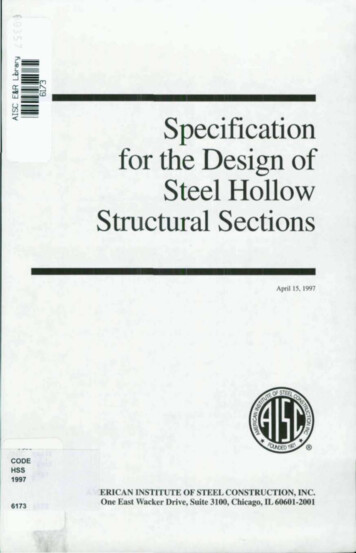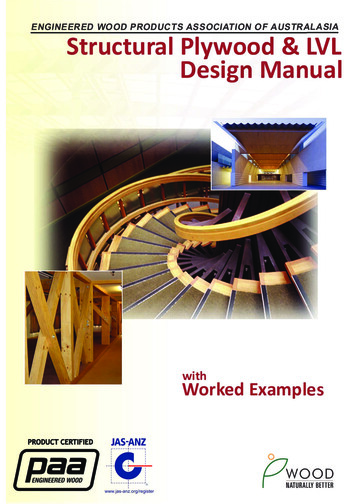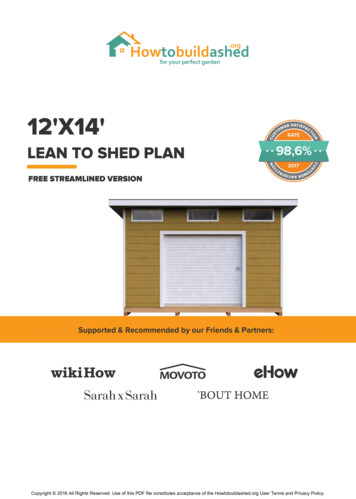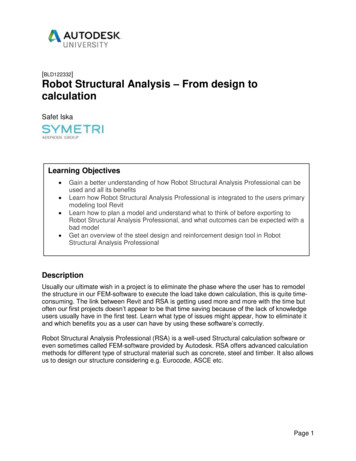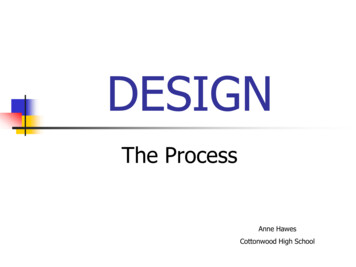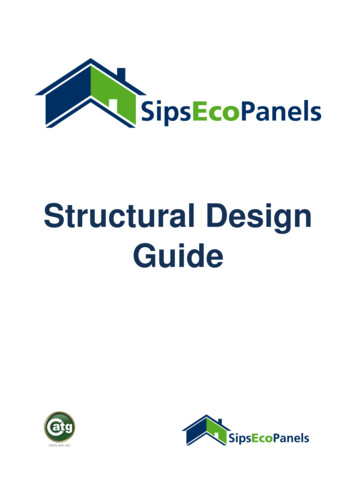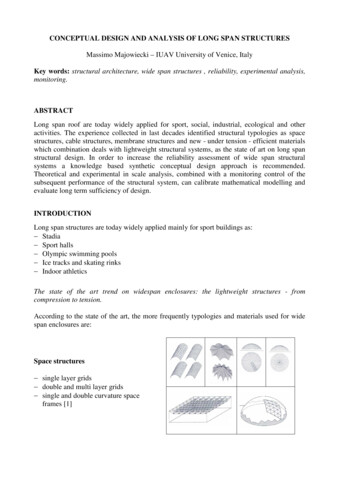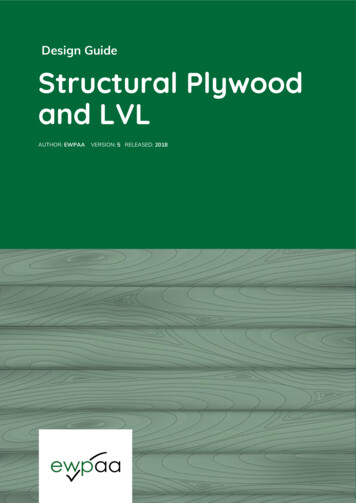
Transcription
Design GuideStructural Plywoodand LVLAUTHOR: EWPAAVERSION: 5 RELEASED: 2018
DisclaimerThe advice provided in this publication is general in nature and is intended as a guide only. Whilst theinformation in this guide was accurate at the time of publication, it is the users’ responsibility toconfirm alignment with current standards and/or building codes. It is also the users’ responsibility toconfirm that they are using the current version of this publication.You should consult the manufacturer of each product for the latest, most accurate information aboutthe product and its use. You should check with the designer or specifier for the project you are workingon to ensure the product and its method of installation are suitable for that project.We provide this publication to you on condition that, to the maximum extent permitted by law, we willnot be liable for any claim you might make for damage arising directly or indirectly from your use ofthe information in the publication.1AUTHOR: EWPAAVERSION: 5 RELEASED: 2018
Table of ContentsTable of Tables . 9Table of Figures . 11Preface. 14Acknowledgements – Original Version. 15Acknowledgements – Revised Version . 161.Plywood & LVL – The Manufacturing Process . 171.1.Introduction . 171.2.Manufacturing Standards . 171.3.Process Control . 171.4.Manufacturing Processes. 172.Structural Plywood . 202.1.Introduction . 202.2.Bond Type . 202.3.Timber Species Used . 202.4.Stress Grades . 202.5.Veneer Quality . 202.6.Specifying Structural Plywood Grades . 212.7.Identification Code . 232.8.Panel Dimensions . 232.9.Other Plywood Types . 242.10. Non-Structural Plywoods . 253.Structural Laminated Veneer Lumber (LVL) . 263.1.Introduction . 263.2.Bond Type . 263.3.Timber Species Used . 263.4.Stress Grade or Structural Properties. 263.5.Veneer Quality . 272AUTHOR: EWPAAVERSION: 5 RELEASED: 2018
3.6.Standard LVL Dimensions . 273.7.Standard Tolerances . 273.8.Specification . 284.Plywood & LVL Physical and Mechanical Properties . 294.1.Introduction . 294.2.Cross-Lamination . 294.3.Dimensional Stability under Changes in Moisture Content . 294.4.Thermal Properties . 304.5.Acoustic Properties. 314.6.Electrical Properties . 324.7.Chemical Resistance . 324.8.Workability and Bending Radii . 324.9.Plywood Density . 335.Structural Plywood - Design Principles & Procedures . 345.1.Introduction – Principles . 345.2.Characteristic Strengths and Stiffness . 345.3.Section Properties . 345.4.Structural Plywood - Loaded Normal to the Face . 355.5.Structural Plywood Loaded in the Plane of the Panel . 375.6.Structural Plywood - Design Procedures . 425.7.Strength & Stiffness limit states design capacities . 425.8.Factors . 456.Structural LVL - Design Principles and Procedures . 546.1.Design Principles . 546.2.Characteristic strengths and stiffness . 546.3.Section Properties . 546.4.LVL – Design Methodology . 566.5.Beam Design . 566.6.Column Design . 596.7.Tension Member Design . 603AUTHOR: EWPAAVERSION: 5 RELEASED: 2018
6.8.Combined Bending and Axial Actions . 616.9.Factors . 627.Basic Structural Plywood & LVL Building Components . 697.1.Introduction . 697.2.Structural Plywood Flooring and Floor Systems . 697.3.Design Issues of Flooring . 697.4.Structural Plywood Flooring – Design Methodology . 707.5.Design Example – Structural Plywood Floor – Specification . 717.6Structural Plywood Floor – Worked Example . 737.6.Structural Plywood Flooring. 767.7.Engineered Flooring System . 767.8.Structural Laminated Veneer Lumber (LVL) and LVL/Plywood I-Beams . 767.9.Structural Plywood Residential Bracing and Combined Bracing/Cladding . 777.10. Structural Plywood Lightweight Roofing Systems . 797.11. Structural Laminated Veneer Lumber (LVL) Framing Members . 797.12. Design Example – LVL Lintel Beam - Specification. 807.13. Structural LVL Lintel Beam: Worked Example . 848.Structural Plywood Webbed Box Beam Design . 898.1.Introduction . 898.2.Beam Components and Materials . 908.3.Design of Nailed Plywood Webbed Box Beams - Methodology . 918.2.Design Example – Nailed Plywood Webbed Box Beam . 948.3.Box Beam Portal Joints . 989.Structural Plywood Diaphragms & Shearwalls . 1029.1.Introduction . 1029.2.Fundamental Relationship . 1039.3.Diaphragm Design – Diaphragm Action . 1049.4.Diaphragm Design – Methodology . 1059.5.Design Example 1 - Diaphragms . 1069.6.Diaphragm Variations . 1154AUTHOR: EWPAAVERSION: 5 RELEASED: 2018
9.7.Design Example 2 – Diaphragms - Openings . 1159.8.Design Example 3 - Diaphragms Horizontal Offsets . 1169.9.Vertical Offsets. 1189.10. Shearwall Design - Panel Response . 1209.11. Shearwall Design - Methodology. 1219.12. Design Example 1 - Shearwalls. 1229.13. Design Example 2 - Shearwalls. 1249.14. Photographs. 12610. Structural Plywood/LVL Gusseted Timber Portal Frames . 12810.1. Introduction . 12810.2. Materials . 12810.3. Plywood / LVL Gusset Design – Gusset Action . 12910.4. Plywood / LVL Gusseted Joints – Methodology . 13510.5. Photographs. 14211. Plywood Stressed Skin Panels . 14511.1. Introduction . 14511.2. Materials . 14611.3. Application . 14711.4. Stressed Skin Panel Design – Panel Action . 14711.5. Panel Design – Methodology . 14911.6. Design Example – Stressed Skin Panels . 15312. Exotic Structural Forms . 16112.1. Introduction . 16112.2. Folded Plates . 16112.3. Folded Plate Design - Structural Action . 16212.4. Folded Plate Design - Methodology . 16312.5. Arches . 16512.6. Arch Design - Arch Action . 16712.7. Arch Design - Methodology . 16712.8. Arches – Design Example . 1685AUTHOR: EWPAAVERSION: 5 RELEASED: 2018
12.9.Arches - Worked Example . 16812.10. Hyperbolic Paraboloids (Hypar) Shells . 17112.11. Hypar Design - Geometry . 17112.12. Hypar Design - Structural Action . 17212.13. Hypar Design - Methodology . 17312.14. Methodology - Principal Membrane Forces . 17512.15. Methodology - Twist in Perimeter Members. 17612.16. Hypar Design - Design Considerations . 17712.17. Domes. 17712.18. Dome Design - Structural Action . 17812.19. Dome Design - Methodology . 17912.20. Spherical Domes - Design Example . 18212.21. Domes – Worked Example . 18212.22. Other Design Considerations. 18312.23. Photographs. 18412.24. Design Aids . 18613. Connection Design – Plywood & LVL . 18713.1.Introduction . 18713.2.Terms and Definitions . 18713.3.Modification Factors – Nailed and Screwed Connectors . 19313.4.Nailed and Screwed Connection Design – Methodology . 19513.5.Design of Type 1 Nailed Connections (Cl. 4.2.3) . 19613.6.Design of Type 2 Nailed Connections . 19613.7.Nailed Connections – Design Example . 19713.8.Design of Screwed Connections . 20013.9.Screwed Connector Design – Methodology . 20013.10. Design of Type 1 Screwed Connection (Cl.4.3.3) . 20013.11. Design of Type 2 Screwed Connections . 20113.12. Design of Bolted Connections . 20213.13. Modification Factors – Bolted Joints . 2036AUTHOR: EWPAAVERSION: 5 RELEASED: 2018
13.14. Bolted connection Design – Methodology . 20513.15. Design of a Type 1 Bolted Connection (Cl.4.4.3) . 20513.16. Design of Type 2 Bolted Connections . 20613.17. Bolted Connection - Design Example . 20913.18. Design of Coach Screwed Connections (Cl.4.5.2). 21313.19. Design of Type 1 Coach Screw Connections . 21313.20. Design Capacity of Type 1 Coach Screwed Joints (Cl.4.5.3) . 21413.21. Design of Type 2 Coach Screwed Connections. 21513.22. Dowelled Connections . 21613.23. Photographs. 21614. Noise Control. 21814.1.Introduction . 21814.2.Nature of Sound. 21814.3.The “A – Weighted” Decibel (dBA) . 21914.4.Sound Pressure Level (SPL) . 21914.5.Transmission Loss (TL) . 21914.6.Sound Transmission Reduction – Airborne & Impact . 22014.7.Subtraction and Addition of Decibels . 22114.8.Sound Barriers (from Ref. 1) - Design Example. 22214.9.Noise in Buildings . 22314.10. Timber Stud Cavity Walls – Airborne Noise. 22414.11. Floor Insulation . 22414.12. Conclusion . 22515. Condensation & Thermal Transmission . 22615.1. Introduction . 22615.2. Condensation – Causes . 22615.3. Condensation – An Explanation . 22615.4. Thermal Transmission – Design Example . 23015.5. Conclusion . 2327AUTHOR: EWPAAVERSION: 5 RELEASED: 2018
16. Resistance to Fire, Decay and Bugs . 23316.1. Introduction . 23316.2. Fire & Wood. 23316.3. Fire Hazard Properties – Test Methods . 23416.4. Plywood and LVL Performance . 23916.5. Resistance to Fire . 23916.6. Steps in Establishing the FRL (Structural Adequacy) . 24016.7. Other Factors . 24116.8. Fire Protection of Joints with Metal Connectors . 24316.9. Resistance to Decay . 24416.10. Resistance to Insect Attack . 24517. Finishing. 24817.1. Dry Interior Applications: . 24817.2. Exterior Applications . 24817.3. Durability and Finishing Applications. 249Reference List . 250Appendix – Chapter 5 . 255Method of Calculation of Section Properties . 255Appendix – Chapter 6 . 260Slenderness Coefficient for Lateral Buckling Under Bending . 260Slenderness coefficient for lateral buckling under compression . 262Appendix – Chapter 8 . 266Bending / Compressive Strength Stability Factor k12 . 266Nail Slip Deflection Equations . 268Panel Shear Slenderness Coefficient, S & Stability Factor k12 for Edge Shear Forces . 2708AUTHOR: EWPAAVERSION: 5 RELEASED: 2018
Table of TablesTable 2-1: Grade Use Guide. 21Table 2-2: Specification Guide for Plywood . 24Table 3-1: Tolerances for LVL . 27Table 3-2: Specification Guide for LVL . 28Table 4-1: Percent Movement of Structural Plywood per Percent Change of Moisture Content. 30Table 4-2: Sound Absorption Coefficients of Various Building Materials . 32Table 4-3: Recommended Minimum Bending Radii for Plywood Linings . 32Table 5-1: Structural Plywood - Characteristic Properties for F-Grades . 34Table 5-2: Load Distribution Widths . 36Table 5-3: Standard Structural Plywood Constructions, Thickness of Parallel Plies ( tp ), SecondMoment of Area (Ip) and Section Modulus (Zp) . 39Table 5-4: Limit State Bending and Shear Strength Capacity – Loading Normal to the Plane of thePlywood Panel . 40Table 5-5: Indicative Stiffness Values (EI) Per mm Width – Loading Normal to the Plane of thePlywood Panel .
1 AUTHOR: EWPAA VERSION: 5 RELEASED: 2018 Disclaimer The advice provided in this publication is general in nature and is intended as a guide only. Whilst the information in this guide was accurate at th

